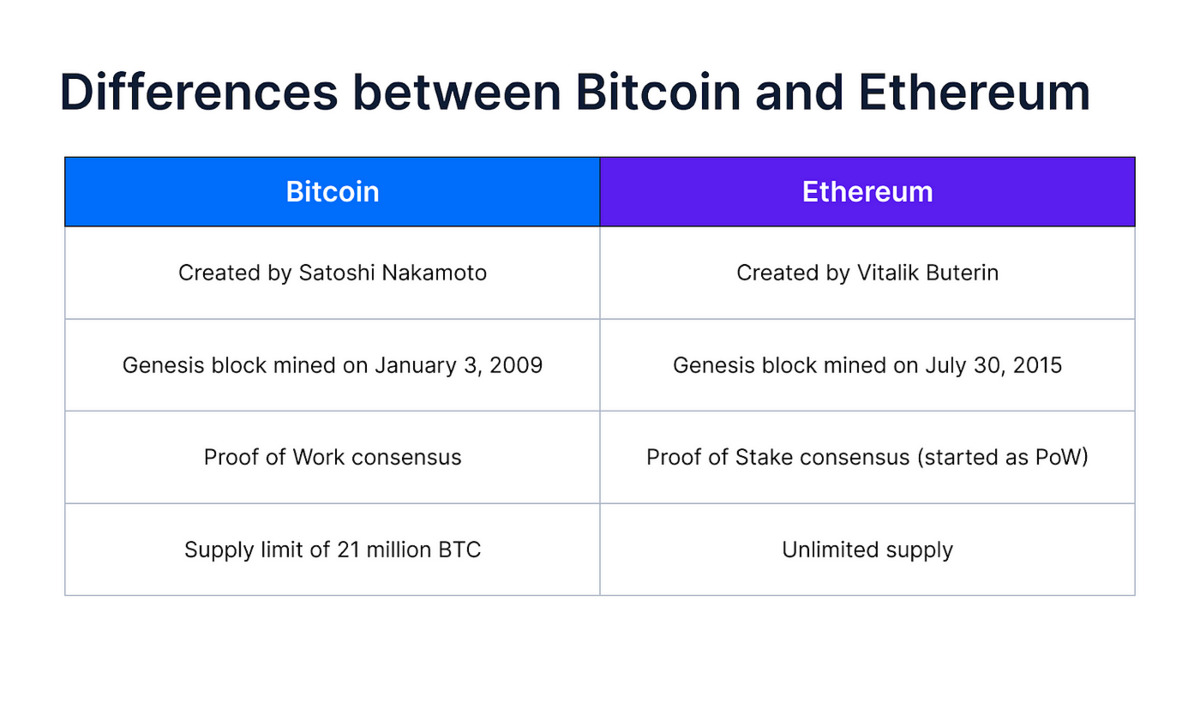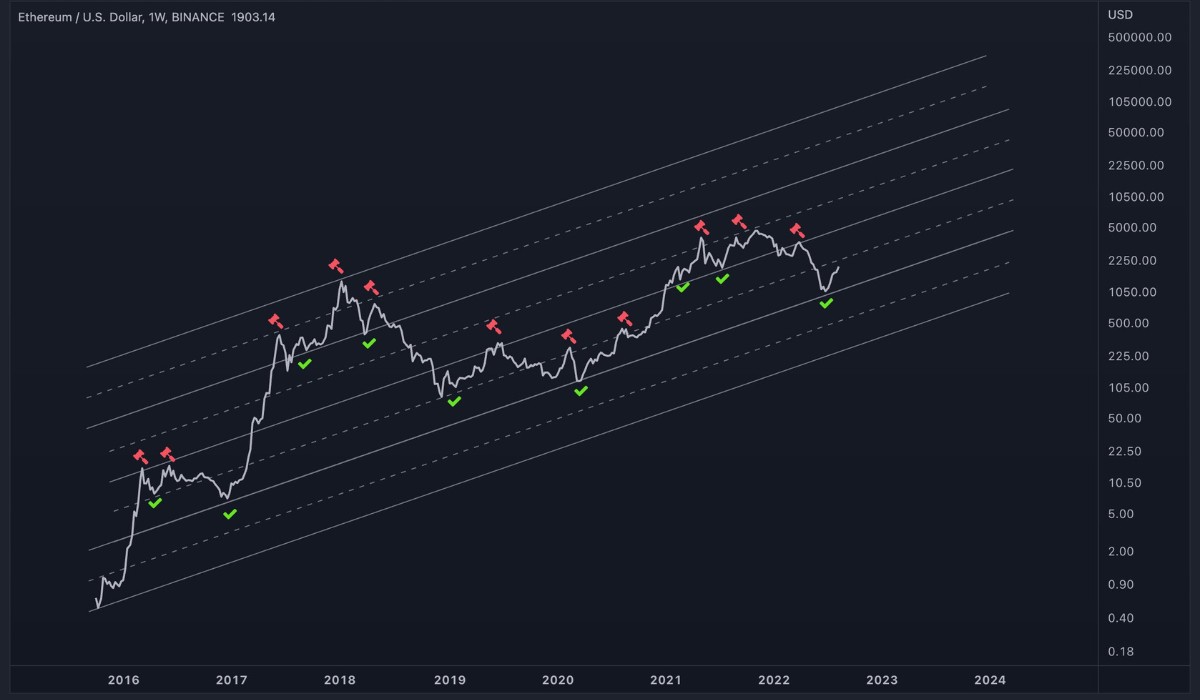Introduction
Welcome to the world of cryptocurrency! If you’re new to this digital realm, you’ve likely heard of Bitcoin and Ethereum. These two popular cryptocurrencies have gained significant attention and sparked curiosity among investors, tech enthusiasts, and everyday users alike. While both Bitcoin and Ethereum operate on blockchain technology, they serve different purposes and have distinct features that set them apart.
In this article, we’ll explore the fundamental differences between Bitcoin and Ethereum. We’ll delve into their purposes, technologies, scalability, supply, consensus algorithms, smart contract functionalities, development communities, and market values. Understanding these differences will give you a clearer perspective on these cryptocurrencies and their unique advantages.
Before we dive into the details, it’s important to note that Bitcoin was the first cryptocurrency to be created in 2009 by an individual or group using the pseudonym Satoshi Nakamoto. Bitcoin aimed to create a decentralized digital currency that could be used as a medium of exchange, just like traditional money. Ethereum, founded by Vitalik Buterin in 2015, took the concept a step further by introducing smart contracts – self-executing contracts with predefined rules and conditions.
Now, let’s explore the key differences between Bitcoin and Ethereum, and how these differences shape their applications and overall ecosystems.
Overview of Bitcoin
Bitcoin, often referred to as the “king of cryptocurrencies,” is the most well-known and widely adopted digital currency in the world. It operates on a decentralized peer-to-peer network, where transactions are verified and recorded on a public ledger called the blockchain.
The primary purpose of Bitcoin is to serve as a decentralized digital currency, allowing users to send and receive funds without the need for intermediaries such as banks or payment processors. Bitcoin transactions provide users with a level of privacy and security, as they are pseudonymous and irreversible once confirmed.
Bitcoin’s technology is built on a proof-of-work (PoW) consensus algorithm, known as mining. Miners compete to solve complex mathematical problems to validate transactions and add them to the blockchain. This process ensures the security and integrity of the network.
Bitcoin’s supply is limited to 21 million coins, a feature designed to alleviate concerns of inflation. As of now, over 18 million Bitcoins have been mined. The scarcity of Bitcoin has contributed to its perceived value and has made it a popular investment asset.
Bitcoin’s core functionality is primarily focused on being a digital currency. While it does have some limited scripting capabilities, its smart contract functionality is relatively basic compared to Ethereum. Bitcoin’s development community primarily focuses on improving the security, scalability, and privacy of the network.
When it comes to market value and trading volume, Bitcoin dominates the cryptocurrency market. It has consistently held the largest market capitalization and has the most active trading volume among all cryptocurrencies. Bitcoin’s wide adoption and recognition have positioned it as a store of value and a digital asset for investment purposes.
In summary, Bitcoin is a decentralized digital currency that operates on a proof-of-work consensus algorithm. Its primary purpose is to act as a medium of exchange, offering users a secure and private method of conducting transactions. Although it has limited smart contract functionality, Bitcoin’s dominance in the cryptocurrency market and its widespread acceptance make it a significant player in the industry.
Overview of Ethereum
Ethereum is known as the “world computer” and is a decentralized platform that enables the development and execution of smart contracts and decentralized applications (dApps). It was created to expand the capabilities of blockchain technology beyond just being a digital currency.
Unlike Bitcoin, which solely focuses on transactions, Ethereum’s primary goal is to provide a platform for developers to build decentralized applications on top of its blockchain. Smart contracts, the cornerstone of Ethereum, are self-executing contracts with predefined rules and conditions. These contracts automatically execute transactions and perform actions based on predetermined criteria.
Ethereum operates on a proof-of-stake (PoS) consensus algorithm, known as Ethereum 2.0. Instead of miners, Ethereum holders who stake their coins are responsible for validating transactions and maintaining the network’s security. Proof-of-stake is more energy-efficient compared to proof-of-work, which Bitcoin uses, making Ethereum a greener and more scalable platform.
One of the key advantages of Ethereum is its advanced smart contract functionality. Developers can use Ethereum’s programming language, Solidity, to create complex and customizable smart contracts. These smart contracts enable a variety of applications, including decentralized finance (DeFi), non-fungible tokens (NFTs), and decentralized exchanges.
Ethereum has a flexible and expandable supply, with no hard cap on the number of Ether (ETH) tokens that can be produced. Currently, there is a fixed issuance rate of Ethereum, but plans are in place to shift to a deflationary model in the future, reducing the supply over time.
The Ethereum development community is vibrant and active, with numerous developers and projects contributing to the ecosystem’s growth. Ethereum’s open-source nature allows for collaboration and innovation, resulting in a wide range of applications and use cases.
In terms of market value and trading volume, Ethereum holds the second-largest market capitalization after Bitcoin. Its popularity stems from its expansive functionality, active development community, and widespread adoption of decentralized applications.
In summary, Ethereum is a decentralized platform that enables developers to build and deploy smart contracts and decentralized applications. It operates on a proof-of-stake consensus algorithm and offers a wide range of functionality beyond being a digital currency. Ethereum’s advanced smart contract capabilities, flexible supply, and active development community position it as a leading player in the digital ecosystem.
Difference in Purpose
One of the key differences between Bitcoin and Ethereum lies in their purpose and primary functions within the cryptocurrency landscape.
Bitcoin was designed to be a decentralized digital currency, aiming to provide an alternative to traditional fiat currencies. Its primary purpose is to act as a medium of exchange, allowing users to send and receive funds without the need for intermediaries. Bitcoin’s focus is on financial transactions, providing a secure, pseudonymous, and borderless means of transferring value globally.
Ethereum, on the other hand, has a broader purpose beyond just being a digital currency. It was created as a decentralized platform that enables the development and execution of smart contracts and decentralized applications (dApps). Ethereum’s primary goal is to provide a framework for developers to build decentralized applications on top of its blockchain, offering programmable functionality and automation through smart contracts.
Smart contracts on Ethereum enable a wide range of applications, such as decentralized finance (DeFi), decentralized exchanges (DEXs), non-fungible tokens (NFTs), and more. Ethereum’s purpose is to provide a platform for the creation of a decentralized internet, where applications can be built and run autonomously without relying on centralized authorities or intermediaries.
While Bitcoin’s purpose is mainly focused on finance and transactions, Ethereum’s purpose expands to include the development of a wide variety of decentralized applications across various industries and sectors. It has opened up new opportunities for developers, businesses, and individuals to leverage blockchain technology and create innovative solutions.
In summary, the difference in purpose between Bitcoin and Ethereum lies in their primary functions. Bitcoin primarily serves as a decentralized digital currency, facilitating peer-to-peer transactions. On the other hand, Ethereum is a platform that enables the development of decentralized applications and smart contracts, expanding the capabilities of blockchain technology beyond just being a currency.
Difference in Technology
The technology behind Bitcoin and Ethereum differs in several key aspects, including their consensus algorithms, scripting languages, and underlying infrastructure.
Bitcoin operates on a proof-of-work (PoW) consensus algorithm, which relies on miners solving complex mathematical problems to validate transactions and add them to the blockchain. This process requires a significant amount of computational power and energy consumption. While PoW ensures the security and immutability of the Bitcoin network, it can be resource-intensive and limits scalability.
Ethereum, on the other hand, is in the process of transitioning to a proof-of-stake (PoS) consensus algorithm, known as Ethereum 2.0. PoS eliminates the need for miners and instead relies on validators who hold and “stake” their Ether (ETH) to secure the network. PoS is more energy-efficient and scales better than PoW, allowing for faster transaction processing and reduced environmental impact.
The scripting languages used in Bitcoin and Ethereum also differ. Bitcoin uses a simple scripting language that allows for basic transactions, such as sending funds from one address to another. These scripts are limited in functionality and primarily focus on defining transaction outputs and conditions.
Ethereum, on the other hand, introduced the Solidity programming language specifically designed for writing smart contracts. Solidity is a Turing-complete language, meaning it can handle complex computations and logic. This allows developers to create sophisticated smart contracts with conditional statements, loops, and other programming constructs, enabling a wide range of decentralized applications.
In terms of infrastructure, Bitcoin and Ethereum have divergent approaches. Bitcoin’s infrastructure mainly consists of its blockchain, which tracks and verifies transactions. While other types of applications can be built on top of Bitcoin, its emphasis is primarily on being a secure and resilient digital currency.
Ethereum, on the other hand, provides a more versatile infrastructure. Its blockchain serves as a platform for hosting not only transactions but also smart contracts and decentralized applications. Ethereum’s infrastructure supports the execution of code and the storage of decentralized application data, opening up a wide range of possibilities for developers.
In summary, Bitcoin and Ethereum vary in terms of their technology. Bitcoin utilizes a PoW consensus algorithm, a simple scripting language, and focuses on being a decentralized currency. Ethereum is in the process of transitioning to a PoS consensus algorithm, supports smart contracts written in Solidity, and provides a more versatile infrastructure to facilitate the development of decentralized applications.
Difference in Scalability
Scalability is a critical aspect of blockchain technology, as it determines how many transactions a network can handle efficiently and at what speed. Both Bitcoin and Ethereum face scalability challenges, but they approach this issue differently.
Bitcoin’s scalability is limited due to its proof-of-work (PoW) consensus algorithm and block size. Each block in the Bitcoin blockchain has a maximum size of 1 megabyte (MB), which imposes a constraint on the number of transactions that can be included in each block. As a result, Bitcoin faces scalability issues during periods of high transaction volume, which can lead to network congestion and increased transaction fees.
Ethereum acknowledges the scalability limitations faced by Bitcoin and aims to address these issues by transitioning to a proof-of-stake (PoS) consensus algorithm, known as Ethereum 2.0. PoS allows for better scalability as it eliminates the need for miners to solve complex mathematical problems, reducing energy consumption and increasing transaction throughput.
In addition to the shift to PoS, Ethereum is implementing various scaling solutions to improve its network’s scalability. One of these solutions is the implementation of sharding, which divides the Ethereum network into smaller, interconnected parts called shards. This allows for parallel processing of transactions and smart contracts, significantly increasing the network’s capacity.
Layer 2 scaling solutions are also being explored in Ethereum. These solutions involve conducting certain transactions off-chain while still ensuring the security and integrity of the main Ethereum blockchain. Examples include state channels, sidechains, and plasma frameworks, which aim to reduce the number of transactions directly processed on the main Ethereum network.
While both Bitcoin and Ethereum face scalability challenges, Ethereum’s transition to PoS, implementation of sharding, and exploration of layer 2 scaling solutions demonstrate a concerted effort to address these limitations and improve scalability. However, it is important to note that these solutions are still in progress, and further development and testing are needed to ensure their effectiveness.
In summary, Bitcoin’s scalability is hindered by its PoW consensus algorithm and limited block size, leading to network congestion and higher transaction fees during high demand. Ethereum acknowledges these challenges and is actively working on implementing PoS, sharding, and layer 2 scaling solutions to improve scalability and increase transaction throughput.
Difference in Supply
The supply of cryptocurrencies plays a crucial role in their value proposition and market dynamics. Bitcoin and Ethereum differ in terms of their supply models and issuance mechanisms.
Bitcoin has a limited supply model, with a maximum cap of 21 million coins. This means that there will only ever be 21 million Bitcoins in existence. This scarcity is built into the protocol as part of its design. Currently, over 18 million Bitcoins have been mined and are in circulation. The remaining Bitcoins are expected to be mined gradually over the coming years.
Ethereum, on the other hand, has a flexible supply. Unlike Bitcoin, Ethereum does not have a hard cap on the number of Ether (ETH) tokens that can be produced. However, there is a fixed issuance rate of Ethereum, which currently stands at 2 ETH per block. This issuance rate ensures a steady supply of ETH entering the market. Ethereum 2.0 is expected to introduce changes to the issuance model, transitioning to a deflationary model that reduces the supply over time.
The difference in supply models has implications for the perceived value and market dynamics of Bitcoin and Ethereum. Bitcoin’s limited supply contributes to its position as a store of value and a hedge against inflation. The notion that there will only ever be a finite number of Bitcoins creates a scarcity mindset among investors, potentially driving up its value over time.
Ethereum’s flexible supply can lead to different market dynamics. Some argue that the absence of a hard cap may affect the value proposition of Ether as a store of value. However, the proposed changes in Ethereum 2.0 aim to address this concern, reducing the supply and potentially increasing the scarcity and value of ETH.
In summary, Bitcoin has a limited supply of 21 million coins, contributing to its perceived scarcity and value as a digital asset. Ethereum has a flexible supply, although changes in Ethereum 2.0 are expected to introduce a deflationary model. The difference in supply models has implications for the perceived value and market dynamics of these two prominent cryptocurrencies.
Difference in Consensus Algorithm
The consensus algorithm is a vital component of blockchain technology, as it determines the process by which transactions are validated and added to the blockchain. Bitcoin and Ethereum employ differing consensus algorithms, resulting in distinct characteristics and performance.
Bitcoin operates on a proof-of-work (PoW) consensus algorithm. In PoW, miners compete to solve complex mathematical problems in order to validate transactions and create new blocks. This competition requires significant computational power and energy consumption. Miners who successfully solve the problem are rewarded with newly minted Bitcoins. PoW ensures the security and immutability of the Bitcoin network, as the computational power required to manipulate the blockchain would be extremely difficult to amass.
Ethereum, on the other hand, is in the process of transitioning from PoW to a proof-of-stake (PoS) consensus algorithm, known as Ethereum 2.0. In PoS, validators are chosen to create new blocks based on the number of coins they hold and are willing to “stake” as collateral. Validators are selected through a combination of random selection and their stake size. PoS is more energy-efficient compared to PoW, as it doesn’t require miners to solve complex mathematical problems. It also allows for faster transaction processing and reduced environmental impact.
The difference in consensus algorithms has several implications. PoW tends to be more secure against network attacks due to the computational effort required. However, it is also resource-intensive and can lead to scalability challenges as the network grows. PoS, on the other hand, addresses these scalability concerns and consumes significantly less energy. It also enables holders of the cryptocurrency to participate in the consensus process and earn rewards based on their stake, fostering a more inclusive and participatory network.
Another notable difference is the transition to Ethereum 2.0, which introduces notable enhancements to the PoS consensus algorithm. These enhancements include mechanisms to reduce centralization and increase network security. Ethereum 2.0 also introduces shard chains, allowing for greater parallel processing and scalability.
In summary, Bitcoin operates on a PoW consensus algorithm, relying on computational power to validate transactions, while Ethereum is transitioning to a PoS consensus algorithm in Ethereum 2.0, emphasizing stakeholder participation and scalability. The difference in consensus algorithms impacts the security, energy consumption, scalability, and decentralized nature of these two prominent cryptocurrencies.
Difference in Smart Contract Functionality
Smart contracts are a key feature of blockchain technology, as they enable the execution of self-executing contracts with predefined rules and conditions. While both Bitcoin and Ethereum support smart contracts, there are significant differences in their functionality and capabilities.
Bitcoin’s smart contract functionality is relatively limited compared to Ethereum. Bitcoin uses a simple scripting language that allows for basic transaction conditions, such as multi-signature requirements or time-locked transactions. These scripting capabilities are primarily focused on defining transaction outputs and conditions. Bitcoin’s scripting language is intentionally designed to be more secure and less prone to bugs or vulnerabilities.
Ethereum, on the other hand, introduced a more advanced smart contract functionality. Ethereum’s programming language, Solidity, allows developers to create complex and customizable smart contracts. Solidity is a Turing-complete language, meaning it can handle complex computations and logic. This enables developers to write smart contracts with conditional statements, loops, and other programming constructs.
Ethereum’s smart contract functionality has opened up a wide range of applications and use cases beyond simple transactions. Developers can utilize smart contracts to build decentralized finance (DeFi) applications, non-fungible token (NFT) marketplaces, decentralized exchanges (DEXs), and more. Ethereum’s rich functionality and flexibility of smart contracts have led to a vibrant ecosystem of decentralized applications built on its platform.
Bitcoin, on the other hand, primarily focuses on being a decentralized digital currency. While it does have some limited scripting capabilities, its smart contract functionality is more constrained compared to Ethereum. The Bitcoin development community primarily prioritizes improving the security, scalability, and privacy of the network, rather than expanding the functionality of smart contracts.
In summary, the difference in smart contract functionality between Bitcoin and Ethereum is substantial. While Bitcoin has limited scripting capabilities focused on basic transaction conditions, Ethereum’s smart contract functionality is more advanced and supports complex programmable logic. This distinction has resulted in Ethereum becoming the leading platform for decentralized applications and tailoring its ecosystem to a wide variety of use cases.
Difference in Development Community
The development community behind a cryptocurrency plays a crucial role in shaping its ecosystem, advancing its technology, and fostering innovation. Bitcoin and Ethereum have distinct development communities with different focuses and objectives.
The Bitcoin development community is oriented towards enhancing the core functionality of the Bitcoin protocol. It consists of a diverse group of developers, cryptographers, and volunteers. The primary focus of the Bitcoin community is on improving the security, scalability, and privacy of the network. They work on optimizing the Bitcoin codebase, implementing protocol upgrades, and addressing vulnerabilities or bugs.
Bitcoin has a strong and passionate community, with debates and discussions centered around issues such as block size, scalability solutions, and network consensus. The community is known for its commitment to preserving the core principles of decentralization and censorship resistance that Bitcoin was built upon.
In contrast, the Ethereum development community is more expansive and diverse. It includes a wide range of developers, entrepreneurs, and researchers who contribute to the development of the Ethereum protocol and its ecosystem. The community is characterized by its focus on building and expanding the capabilities of smart contracts and decentralized applications (dApps).
Ethereum’s development community is highly active and open to experimentation. It fosters innovation through regular updates, new protocol proposals, and development grants. Developers within the Ethereum ecosystem contribute to projects ranging from DeFi applications and NFT platforms to decentralized exchanges and governance frameworks.
The Ethereum development community has also embraced the concept of community-driven decision-making, as evident in the Ethereum Improvement Proposals (EIPs) process. This process allows developers and community members to propose and discuss changes to the Ethereum protocol, fostering a sense of inclusivity and collaboration.
Furthermore, Ethereum’s development community has been instrumental in driving the shift from a proof-of-work (PoW) consensus algorithm to proof-of-stake (PoS) in Ethereum 2.0. This transition reflects the collective efforts and collaboration within the Ethereum community to address the scalability challenges faced by the network.
In summary, the development communities of Bitcoin and Ethereum differ in their focus and objectives. The Bitcoin community primarily emphasizes enhancing the security, privacy, and scalability of the network, while the Ethereum community is actively driving innovation and expanding the capabilities of smart contracts and decentralized applications. Both communities bring unique contributions to their respective ecosystems, shaping the future of these cryptocurrencies and blockchain technology as a whole.
Difference in Market Value and Trading Volume
The market value and trading volume of cryptocurrencies are important indicators of their popularity and adoption. When comparing Bitcoin and Ethereum, there are significant differences in their market value and trading volume.
Bitcoin, being the first and most well-known cryptocurrency, has established itself as the dominant player in the market. It has consistently held the largest market capitalization among all cryptocurrencies, often comprising a significant portion of the entire cryptocurrency market. Bitcoin’s market value is driven by factors such as its scarcity, widespread recognition, and reputation as a store of value.
Bitcoin also boasts the highest trading volume in the cryptocurrency market. It is actively traded on numerous exchanges, with high liquidity and a widespread user base. Bitcoin’s trading volume indicates the level of interest and activity surrounding the cryptocurrency, reflecting its status as a preferred asset for speculation, investment, and peer-to-peer transactions.
Ethereum, while holding a substantial market capitalization, typically ranks below Bitcoin in terms of overall market value. However, Ethereum has carved out a significant niche in the cryptocurrency market due to its unique capabilities for supporting decentralized applications and smart contracts. It has gained widespread recognition for its role in fueling the decentralized finance (DeFi) ecosystem and the booming popularity of non-fungible tokens (NFTs).
When it comes to trading volume, Ethereum consistently ranks among the top cryptocurrencies. The Ethereum blockchain serves as the foundation for numerous tokens and dApps, making it an active part of the cryptocurrency trading landscape. Ethereum’s trading volume is driven by the demand for its native currency, Ether (ETH), as well as the trading activity of tokens and projects built on top of its blockchain.
It is worth noting that the market value and trading volume of cryptocurrencies can be influenced by various factors, including market sentiment, technological advancements, regulatory changes, and broader economic trends. As such, the market dynamics of Bitcoin and Ethereum may fluctuate over time as new developments and trends emerge within the cryptocurrency ecosystem.
Overall, Bitcoin maintains a dominant position in terms of market value and trading volume, largely due to its status as the first and most recognized cryptocurrency. However, Ethereum has secured a significant presence in the market, driven by its unique functionalities and role in powering decentralized applications and tokens. Both cryptocurrencies play critical roles in the broader cryptocurrency market, serving different purposes and attracting different segments of users and investors.
Conclusion
In conclusion,
Bitcoin and Ethereum are two of the most prominent cryptocurrencies in the digital landscape, each with its own unique characteristics and offerings. Bitcoin, as the first cryptocurrency, is primarily focused on being a decentralized digital currency and a store of value. Ethereum, on the other hand, goes beyond just being a currency and serves as a platform for building decentralized applications and executing smart contracts.
The differences between Bitcoin and Ethereum extend beyond their purposes. They diverge in their technology, with Bitcoin utilizing a proof-of-work consensus algorithm and Ethereum transitioning to a proof-of-stake consensus algorithm in Ethereum 2.0. Ethereum’s smart contract functionality is more advanced and flexible, allowing for the creation of complex applications, while Bitcoin’s scripting capabilities are more basic.
Scalability is another area where Bitcoin and Ethereum differ. Bitcoin faces scalability challenges due to its block size and proof-of-work mechanism, while Ethereum is actively working on implementing scaling solutions such as sharding and layer 2 solutions to improve its scalability.
Other distinguishing factors include the supply models of Bitcoin and Ethereum, with Bitcoin having a limited supply and Ethereum having a flexible supply. The development communities of both cryptocurrencies also have different focuses and objectives, with Bitcoin’s community emphasizing the core functionality and security of the network while Ethereum’s community drives innovation and expansion of smart contract capabilities.
Furthermore, there are differences in the market value and trading volume of Bitcoin and Ethereum. Bitcoin holds the largest market capitalization and highest trading volume, while Ethereum has gained significant popularity due to its role in decentralized applications and the growing DeFi and NFT sectors.
Both Bitcoin and Ethereum have contributed to the evolution of the cryptocurrency industry and have captured the attention and interest of investors and users worldwide. While they have similarities as cryptocurrencies built on blockchain technology, their unique features, purposes, and communities make them stand out in their own ways.
As the cryptocurrency market continues to evolve, Bitcoin and Ethereum will play important roles in shaping the future of digital currencies and decentralized applications. Their contributions, innovations, and ongoing developments have set the stage for further advancements in blockchain technology and the broader adoption of cryptocurrencies in various sectors.

























